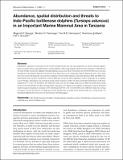Files in this item
Abundance, spatial distribution and threats to Indo-Pacific bottlenose dolphins (Tursiops aduncus) in an Important Marine Mammal Area in Tanzania
Item metadata
| dc.contributor.author | Kasuga, Magreth | |
| dc.contributor.author | Varisanga, Modest | |
| dc.contributor.author | Davenport, Tim | |
| dc.contributor.author | Jiddawi, Narriman | |
| dc.contributor.author | Braulik, Gill | |
| dc.date.accessioned | 2022-09-12T11:30:03Z | |
| dc.date.available | 2022-09-12T11:30:03Z | |
| dc.date.issued | 2022-08-23 | |
| dc.identifier | 280995258 | |
| dc.identifier | 1f2d493c-018f-4d4b-b742-533f4a919a8a | |
| dc.identifier | 85144724020 | |
| dc.identifier.citation | Kasuga , M , Varisanga , M , Davenport , T , Jiddawi , N & Braulik , G 2022 , ' Abundance, spatial distribution and threats to Indo-Pacific bottlenose dolphins ( Tursiops aduncus ) in an Important Marine Mammal Area in Tanzania ' , Western Indian Ocean Journal of Marine Science , vol. 21 , no. 1 , 215382 . https://doi.org/10.4314/wiojms.v21i1.1 | en |
| dc.identifier.issn | 0856-860X | |
| dc.identifier.other | ORCID: /0000-0001-8919-4187/work/117996805 | |
| dc.identifier.uri | https://hdl.handle.net/10023/25992 | |
| dc.description | Funding: Thanks to the US Marine Mammal Commission (MMC) and the People’s Trust for Endangered Species who funded his work via the Wildlife Conservation Society (WCS). | en |
| dc.description.abstract | Abundance estimates of cetaceans in the western Indian Ocean are rare, but important, as many cetacean populations are under threat, especially those in coastal habitats. This study aimed to generate first estimates of abundance for Indo-Pacific bottlenose dolphins (Tursiops aduncus), assessed as Near Threatened on the IUCN Red List, in an area identified by the Marine Mammal Protected Area Task Force as an ‘Important Marine Mammal Area’. Two study sites were surveyed along the east and west coastlines of the Pemba Channel, Tanzania. In west Pemba, between 2014 and 2016 four boat-based visual surveys conducted a total of 2467 km of survey effort sighting a total of 16 groups of T. aduncus in west Pemba. Abundance was estimated using mark-recapture models of photo-identified individuals as 89 animals (CV 7.7%, 95% CI 72-103) in the 1084km2 study area. In the Tanga study area in 2016 two boat-based visual surveys covered 1254 km of effort during which 15 groups of T. aduncus were sighted, resulting in a photo-ID based mark-recapture abundance estimate of 177 individuals (CV 8.6%, 95% CI 150-210) in the 1562 km2 study site. Group encounter rate for this species in Tanga was double that recorded in the Pemba study site. A total of 23% of identified dolphins bore the scars of interactions with fishing gear. | |
| dc.format.extent | 14 | |
| dc.format.extent | 2365617 | |
| dc.language.iso | eng | |
| dc.relation.ispartof | Western Indian Ocean Journal of Marine Science | en |
| dc.subject | Indo-Pacific bottlenose dolphin | en |
| dc.subject | Tursiops aduncus | en |
| dc.subject | Abundance | en |
| dc.subject | Photo-identification | en |
| dc.subject | Important marine mammal area | en |
| dc.subject | Western Indian ocean | en |
| dc.subject | GC Oceanography | en |
| dc.subject | QL Zoology | en |
| dc.subject | NDAS | en |
| dc.subject | SDG 14 - Life Below Water | en |
| dc.subject | AC | en |
| dc.subject | MCC | en |
| dc.subject.lcc | GC | en |
| dc.subject.lcc | QL | en |
| dc.title | Abundance, spatial distribution and threats to Indo-Pacific bottlenose dolphins (Tursiops aduncus) in an Important Marine Mammal Area in Tanzania | en |
| dc.type | Journal article | en |
| dc.contributor.institution | University of St Andrews. School of Biology | en |
| dc.identifier.doi | 10.4314/wiojms.v21i1.1 | |
| dc.description.status | Peer reviewed | en |
This item appears in the following Collection(s)
Items in the St Andrews Research Repository are protected by copyright, with all rights reserved, unless otherwise indicated.

